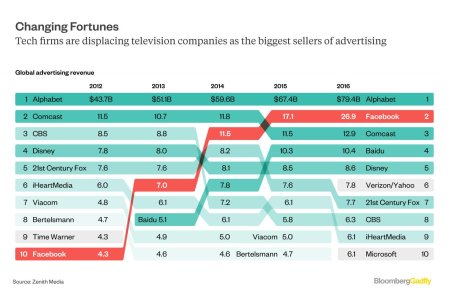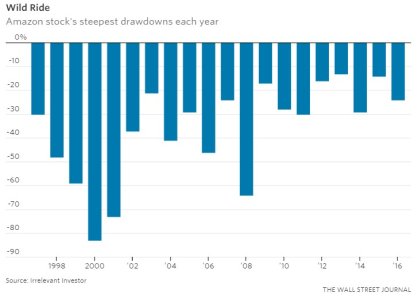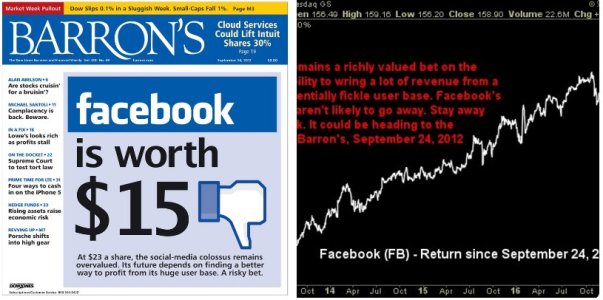elementare, W:
Artificial intelligence: Can Watson save IBM? - FT.com
The history of artificial intelligence has been marked by seemingly revolutionary moments — breakthroughs that promised to bring what had until then been regarded as human-like capabilities to machines.
The AI highlights reel includes the “expert systems” of the 1980s and Deep Blue, IBM’s world champion-defeating chess computer of the 1990s, as well as more recent feats like the Google system that taught itself what cats look like by watching YouTube videos.
But turning these clever party tricks into practical systems has never been easy. Most were developed to showcase a new computing technique by tackling only a very narrow set of problems, says Oren Etzioni, head of the AI lab set up by Microsoft co-founder Paul Allen. Putting them to work on a broader set of issues presents a much deeper set of challenges.
Few technologies have attracted the sort of claims that IBM has made for Watson, the computer system on which it has pinned its hopes for carrying AI into the general business world. Named after Thomas Watson Sr, the chief executive who built the modern IBM, the system first saw the light of day five years ago, when it beat two human champions on an American question-and-answer TV game show, Jeopardy!
But turning Watson into a practical tool in business has not been straightforward. After setting out to use it to solve hard problems beyond the scope of other computers, IBM in 2014 adapted its approach.
Rather than just selling Watson as a single system, its capabilities were broken down into different components: each of these can now be rented to solve a particular business problem, a set of 40 different products such as language-recognition services that amount to a less ambitious but more pragmatic application of an expanding set of technologies.
Though it does not disclose the performance of Watson separately, IBM says the idea has caught fire. John Kelly, an IBM senior vice-president and head of research, says the system has become “the biggest, most important thing I’ve seen in my career” and is IBM’s fastest growing new business in terms of revenues.
But critics say that what IBM now sells under the Watson name has little to do with the original Jeopardy!-playing computer, and that the brand is being used to create a halo effect for a set of technologies that are not as revolutionary as claimed.
“Their approach is bound to backfire,” says Mr Etzioni. “A more responsible approach is to be upfront about what a system can and can’t do, rather than surround it with a cloud of hype.”
Nothing that IBM has done in the past five years shows it has succeeded in using the core technology behind the original Watson demonstration to crack real-world problems, he says.
The debate over Watson’s capabilities is more than just an academic exercise. With much of IBM’s traditional IT business shrinking as customers move to newer cloud technologies, Watson has come to play an outsized role in the company’s efforts to prove that it is still relevant in the modern business world. That has made it key to the survival of Ginni Rometty, the chief executive who, four years after taking over, is struggling to turn round the company.
Watson’s renown is still closely tied to its success on Jeopardy! “It’s something everybody thought was ridi****usly impossible,” says Kris Hammond, a computer science professor at Northwestern University. “What it’s doing is counter to what we think of as machines. It’s doing something that’s remarkably human.”
By divining the meaning of cryptically worded questions and finding answers in its general knowledge database, Watson showed an ability to understand natural language, one of the hardest problems for a computer to crack. The demonstration seemed to point to a time when computers would “understand” complex information and converse with people about it, replicating and eventually surpassing most forms of human expertise.
The biggest challenge for IBM has been to apply this ability to complex bodies of information beyond the narrow confines of the game show and come up with meaningful answers. For some customers, this has turned out to be much harder than expected.
The University of Texas’s MD Anderson Cancer Center began trying to train the system three years ago to discern patients’ symptoms so that doctors could make better diagnoses and plan treatments.
“It’s not where I thought it would go. We’re nowhere near the end,” says Lynda Chin, head of innovation at the University of Texas’ medical system. “This is very, very difficult.” Turning a word game-playing computer into an expert on oncology overnight is as unlikely as it sounds, she says.
Part of the problem lies in digesting real-world information: reading and understanding reams of doctors’ notes that are hard for a computer to ingest and organise. But there is also a deeper epistemological problem. “On Jeopardy! there’s a right answer to the question,” says Ms Chin but, in the
medical world, there are often just well-informed opinions.
Mr Kelly denies IBM underestimated how hard challenges like this would be and says a number of medical organisations are on the brink of bringing similar diagnostic systems online.
IBM’s initial plan was to apply Watson to extremely hard problems, announcing in early press releases “moonshot” projects to “end cancer” and accelerate the development of Africa. Some of the promises evaporated almost as soon as the ink on the press releases had dried. For instance, a far-reaching partnership with Citibank to explore using Watson across a wide range of the bank’s activities, quickly came to nothing.
Since adapting in 2014, IBM now sells some services under the Watson brand. Available through APIs, or programming “hooks” that make them available as individual computing components, they include sentiment analysis — trawling information like a collection of tweets to assess mood — and personality tracking, which measures a person’s online output using 52 different characteristics to come up with a verdict.
At the back of their minds, most customers still have some ambitious “moonshot” project they hope that the full power of Watson will one day be able to solve, says Mr Kelly; but they are motivated in the short term by making improvements to their business, which he says can still be significant.
This more pragmatic formula, which puts off solving the really big problems to another day, is starting to pay dividends for IBM. Companies like Australian energy group Woodside are using Watson’s language capabilities as a form of advanced search engine to trawl their internal “knowledge bases”. After feeding more than 20,000 documents from 30 years of projects into the system, the company’s engineers can now use it to draw on past expertise, like calculating the maximum pressure that can be used in a particular pipeline.
To critics in the AI world, the new, componentised Watson has little to do with the original breakthrough and waters down the technology. “It feels like they’re putting a lot of things under the Watson brand name — but it isn’t Watson,” says Mr Hammond.
Mr Etzioni goes further, claiming that IBM has done nothing to show that its original Jeopardy!-playing breakthrough can yield results in the real world. “We have no evidence that IBM is able to take that narrow success and replicate it in broader settings,” he says. Of the box of tricks that is now sold under the Watson name, he adds: “I’m not aware of a single, super-exciting app.” To IBM, though, such complaints are beside the point. “Everything we brand Watson analytics is very high-end AI,” says Mr Kelly, involving “machine learning and high-speed unstructured data”. Five years after Jeopardy! the system has evolved far beyond its original set of tricks, adding capabilities such as image recognition to expand greatly the range of real-world information it can consume and process.
This argument may not matter much if the Watson brand lives up to its promise. It could be self-fulfilling if a number of early customers adopt the technology and put in the work to train the system to work in their industries, something that would progressively extend its capabilities.
IBM is pinning its hopes on turning a smart machine’s box of tricks into practical applications, says Richard Waters. Can it capitalise on its system’s promise of bringing an AI revolution to business?
“Once it’s working, you want to be leading the adoption,” says Shaun Gregory, head of technology and strategy at Woodside. “You’re ahead in knowledge and learning. Machines never forget,” he says.
Another challenge for early users of Watson has been knowing how much trust to put in the answers the system produces. Its probabilistic approach makes it very human-like, says Ms Chin at MD Anderson. Having been trained by experts, it tends to make the kind of judgments that a human would, with the biases that implies.
In the business world, a brilliant machine that throws out an answer
to a problem but cannot explain itself will be of little use, says Mr Hammond. “If you walk into a CEO’s office and say we need to shut down three factories and sack people, the first thing the CEO will say is: ‘Why?’” He adds: “Just producing a result isn’t enough.”
IBM’s attempts to make the system more transparent, for instance by using a visualisation tool called WatsonPaths to give a sense of how it reached a conclusion, have not gone far enough, he adds.
Mr Kelly says a full audit trail of Watson’s decision-making is embedded in the system, even if it takes a sophisticated user to understand it. “We can go back and figure out what data points Watson connected” to reach its answer, he says.
He also contrasts IBM with other technology companies like Google and Facebook, which are using AI to enhance their own services or make their advertising systems more effective. IBM is alone in trying to make the technology more transparent to the business world, he argues: “We’re probably the only ones to open up the black box.”
Even after the frustrations of wrestling with Watson, customers like MD Anderson still believe it is better to be in at the beginning of a new technology.
“I am still convinced that the capability can be developed to what we thought,” says Ms Chin. Using the technology to put the reasoning capabilities of the world’s oncology experts into the hands of other doctors could be far-reaching: “The way Amazon did for retail and shopping, it will change what care delivery looks like.”
Ms Chin adds that Watson will not be the only reasoning engine that is deployed in the transformation of healthcare information. Other technologies will be needed to complement it, she says.
Five years after Watson’s game show gimmick, IBM has finally succeeded in stirring up hopes of an AI revolution in business. Now, it just has to live up to the promises.
Key assets: Systems depend on diverse data flows
There is a secret weapon in the race between leading tech companies to create the most effective forms of artificial intelligence: access to large amounts of data. For IBM, as it tries to make Watson a new standard for AI in the business world, this could turn out to be an under-appreciated advantage, according to some experts.
At the heart of intelligent machines are algorithms that search through large volumes of data to identify patterns and make surmises. Machine learning — the basic technique behind many of the recent advances in AI — relies on using large amounts of data to train systems in this way.
“A lot of what is now emerging with AI technologies has to do with data,” says Kris Hammond, a computer science professor at Northwestern University.
One of the biggest reasons for recent advances in AI has been the availability of large amounts of data online with which to train systems. Google has perfected its search systems by harnessing the abundant data it collects about the online behaviour of its users. While IBM cannot match the massive trove of information Google has at its disposal, what it lacks in volume it hopes to make up for in industry-specific detail.
“Google has one kind of data — consumer sentiment data. We have a vast amount of [more diverse] data,” says John Kelly, head of research at IBM.
The more industry-specific data it is fed, the smarter it will become at solving business problems. As customers pour their own corporate information into Watson in order to train it, IBM stands to be a beneficiary.
Watson’s “expanding corpus of information in many domains” could turn out to be one of IBM’s main assets in the AI race, says Mr Hammond.
Last year, IBM turned to acquisitions to boost its reserves of data. These included the $1bn it spent to buy Merge Healthcare, a company that handles large amounts of medical images. It has been folded into Watson Health, the first industry-specific business unit to be spun out of the Watson division.
It also spent $2bn to buy the digital assets of the Weather Company, with the aim of feeding its weather data into forecasting systems geared to understanding weather-related business risks, among other functions.
“Between our customers and what we’ve acquired, we’re amassing quite a data set,” says Mr Kelly.
Spinning this basic raw material into computing gold still requires serious technical skills. But if it can persuade customers to contribute their own data to the task of making Watson smarter, it could deliver the sort of head start that will make it hard for rivals to catch up.


